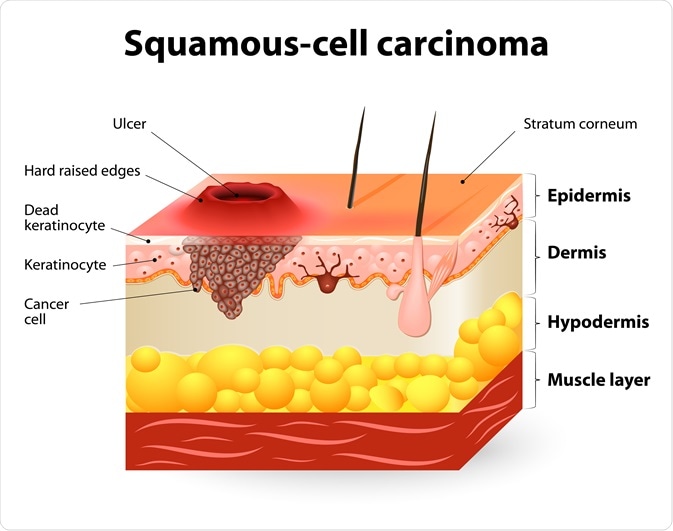Squamous cell carcinoma (SCC) is a skin condition that involves abnormal growth of the squamous cells, although the changes may be subtle at first. Many patients that present with the condition have a long history of a lesion that fails to heal, that they have not associated with a sign of a serious health condition.
The signs and symptoms can vary greatly according to the area of the skin and organs that are involved. For example, vision may be affected if the lesion is on the face and nervous symptoms may present with the involvement of the nerves.
 Squamous cell carcinoma of a human. Image Credit: Designua / Shutterstock.com
Squamous cell carcinoma of a human. Image Credit: Designua / Shutterstock.com
Initial presentation
The initial lesion does not usually cause any symptoms and the first noticeable signs are largely visual. Actinic keratosis is a skin condition involving tiny spots on the skin that are precancerous but have a higher risk of progressing to become squamous cell carcinoma.
The tumor typically begins as a small nodule on skin the that enlarges and becomes a shallow ulcer that does not easily heal. It is common for the edges to be hardened and heaped up and the lesion to be covered by plaque that continues to grow in the area. Some patients may find that the tumor occasionally bleeds, usually from the lip of the lesion.
However, the physical presentation of squamous cell carcinoma is highly variable and not all patients experience the same signs and symptoms. The location of the lesion also has a large impact on the appearance and symptoms of the condition.
Affected area
Squamous cell carcinoma usually affects particular areas of the skin, due to the risk factors that affect these regions. For example, exposure to ultraviolet (UV) radiation in sunlight is the primary causative factor for the condition, as it can lead to DNA damage and change the replication and growth of the squamous cells. For this reason, areas of the skin that are commonly exposed to sunlight, such as the head and neck, are most likely to be affected.
In fact, approximately 70% of SCC cases occur on the head and neck, and should thus be examined closely for signs of skin changes. If lesions present nearby the eyes, patients may notice changes in vision.
For more advanced cases, the cancerous cells can spread to nearby lymph nodes, causing them to become enlarged. Occasionally, the tumor can rest underneath the level of surrounding skin and invade deeper tissues when it ulcerates.
 Diagram of squamous cell carcinoma. Image Credit: Designua / Shutterstock.com
Diagram of squamous cell carcinoma. Image Credit: Designua / Shutterstock.com
Tumor characteristics
The surface changes to the skin as a result of squamous cell carcinoma typically include:
- Scaling
- Ulceration
- Crusting
- Cutaneous Horn
In some cases, a pink cutaneous nodule may present, although this is less common.
The size of the tumor is an important factor that affects the appropriate treatment choice, as it can affect the likelihood of metastases. For example, lesions greater than 2cm are on the ears or lips of an individual are at a particularly high risk of metastasizing.
Peripheral nerve involvement
Some patients may report particular symptoms that a likely to indicate the involvement of peripheral nerves in the area. These symptoms may include:
- Numbness
- Pain
- Muscular twitching
- Muscular weakness
References
Further Reading